The Traditional Romanian Apple Pie
The pupils in ”Constantin Noica” Theoretical High School Sibiu, helped by their Erasmus+ ”Folklorica” coordinator, Mrs. Gabriela Mirela Jugar have prepared an apple pie and recommended to their partners from Turkey, Poland, Spain, Cyprus and Lithuania its recipe. They wrote in their text about time, servings, ingredients such as flour, sugar, vegetable oil, white vinegar, sodium bicarbonate, peeled cored apples, lemon juice, cinnamon, as well as the sixteen phases of the metod of preparing this apple pie. The Romanian pupils have used the apples received gratuitously at school within the program „Croissant, Milk and Fruit”. Then they added two photos with the final product in a tray, invited the partners to trying to make it and wished them ”Good appetite!”.
Sânziana Salomie, teacher in ”Constantin Noica” High School Sibiu
Romanian Apple Pie.pdf
Plăcinta tradițională românească
Elevii Liceului Teoretic „Constantin Noica” Sibiu, ajutați de coordonatoarea lor din cadrul proiectului Erasmus+ „Folklorica”, doamna Gabriela Mirela Jugar, au pregătit o plăcintă cu mere și le-au recomandat partenerilor lor din Turcia, Polonia, Spania, Cipru și Lituania rețeta ei. Au scris în textul lor despre timp, porții, ingrediente cum ar fi făină, ulei vegetal, oțet alb, bicarbonat de sodiu, mere cu coaja curățată, suc de lămâie, scorțișoară, precum și cele șaisprezece faze ale metodei de preparare a acestei plăcinte cu mere. Elevii români au folosit merele primite gratuit la școală în cadrul programului „Corn, lapte și fructe”. Apoi au adăugat două fotografii cu produsul final într-o tavă, i-au invitat pe parteneri să încerce să o facă și le-au urat „Poftă bună!”.
Raluca Teglaș, profesor al Liceului Teoretic ”Constantin Noica” Sibiu
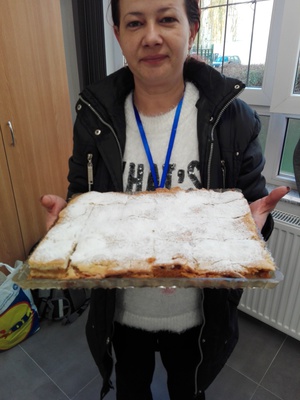
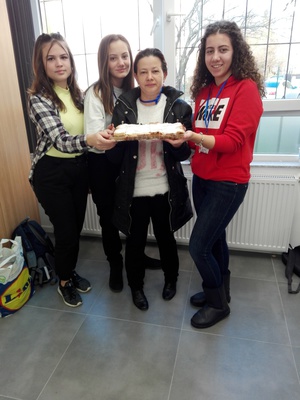
RECIPE OF GRANDMOTHERS
The pupils in the workgroup of the Erasmus+ project “Folklorica” prepared a traditional cake to present to their friends in the partnership formed by schools from Romania, Poland, Lithuania, Cyprus and Spain. First the pupilsmet in the house of a friend’s grandmother. Then they had an interview with her. The aim here was to learn the recipe of traditional cake. During the interview, they had a record to show to their friends and partners. The next day, using the recipe that they had learned from grandmother, students managed to bake the cake. When it was ready to be served, kids brought it to school and shared with the teachers in the project team. Good work kids!
Umut Uysaler, coordinator, Vali M. Lutfullah Bilgin School
NİNELERİN TARİFİ
Erasmus+ projesi “Folkorica” çalışma grubunda yer alan öğrenciler; Romanya, Polonya, Litvanya, Güney Kıbrıs ve İspanya dan okulların oluşturduğu ortaklıktaki arkadaşlarına sunmak üzere geleneksel bir kek hazırladılar.Öğrencilerimiz, önce, ninelerinin evinde buluştular. Sonrasında, onunla bir röportaj yaptılar. Amaç, geleneksel kek tarifini öğrenmekti. Röportaj sırasında, arkadaşlarına ve ortaklarına göstermek üzere birde video çekimi yaptılar. Ertesi gün, ninelerinden öğrendikleri tarifi kullanarak, kek yapmayı başardılar. Kek servise hazır olduğunda, okula getirip proje ekibindeki öğretmenleriyle paylaştılar. Ellerinize sağlık çocuklar!
Hulusi Gürbüz, okul müdürü, Vali M. Lutfullah Bilgin Ortaokulu
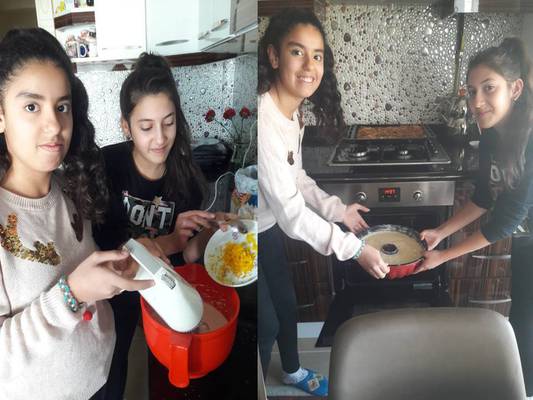
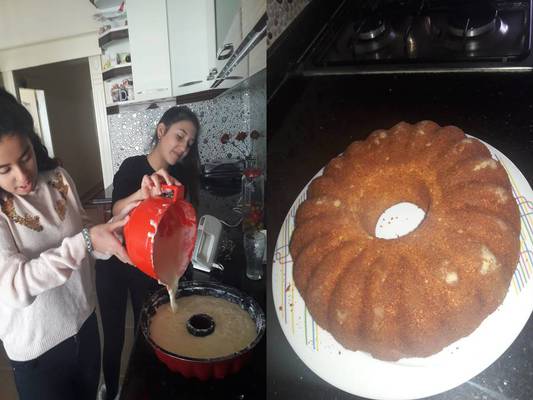
The Two Romanian Menus
Within the set of activities entitled ”Cuisines”, as we established in our second mobility, we have written in order to share to our project partners two menus, each of them consisting in three dishes: a starter, a main dish and a dessert. The starter for the first menu was ” Fried Cheese”. The ”Chicken Noodle Soup” was the main dish and the ”Cheese Doughnuts” represented the dessert. The starter for the second menu was ” Fish Roe Dip”. The ”Beef Steak with Carrot Purée” was the main dish and, as dessert, we have suggested the recipe of the ”Plum Dumplings”, characteristic to Transylvania. For each dish of the two menus, we have given the ingredients and the preparation directions. At the end of the second menu, we wished to everybody ”Good appetite!” in English, the language of this project, and in all the six languages of the Erasmus+ partners.
Gabriela Mirela Jugar, coordinator in ”Constantin Noica” High School Sibiu
The 1st Romanian Menu.docx
The 2nd Romanian Menu.docx
Cele două meniuri românești
În cadrul activității intitulate „Bucătărie”, așa cum am stabilit în cea de-a doua mobilitate, am scris pentru a împărtăși partenerilor noștri din proiect două meniuri, fiecare dintre ele constând în trei feluri de mâncare: un aperitiv, un fel de mâncare principal și un desert. Aperitivul pentru primul meniu a fost „Cașcaval pane”. „Supa de pui cu tăiței” a fost felul principal de mâncare, iar ”Papanașii” au reprezentat desertul. Aperitivul pentru cel de-al doilea meniu a fost ”Salată de icre”. ”Friptura de vită cu piure de morcovi” a fost felul principal de mâncare și, ca desert, am sugerat rețeta „Găluștelor de prune”, caracteristice Transilvaniei. Pentru fiecare fel de mâncare din cele două meniuri, am dat ingredientele și instrucțiunile de pregătire. La sfârșitul celui de-al doilea meniu, noi le-am urat tuturor ”Poftă bună!” în engleză, limba acestui proiect, și în toate cele șase limbi ale partenerilor Erasmus +.
Daniela Cioplea, profesor, Liceul ”Constantin Noica” Sibiu, România
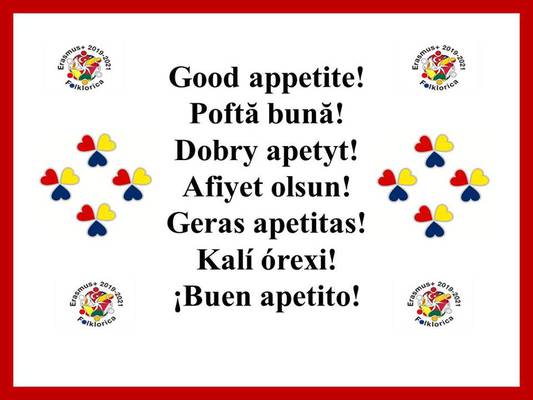
Description of the Spanish Recipes
First, we described for our Erasmus+ partners a dish that can served both as a start or a main dish. Its name is “old clothes”. We gave them the ingredients and the preparation process. Besides, we precised the fact that the most importantly is finally to share. The carnival pancakes and “Prince Albert cake, as well as chocolate and cookies cake represent the desserts described by the team from the Canary Islands. The Erasmus+ friends could find in a Word document not only texts but also potos of the dishes. The ingrediends and the preparations of the cake, which had to be served very cold, were not only for the sponge but also for the mousse.
Sara González Gil, coordinator, IES Pérez Galdós, Spain
Spanish Recipes.doc
CHOCOLATE AND COOKIES CAKE.doc
Descripción de las recetas españolas
Primero, describimos para nuestros socios de Erasmus+ un plato que puede servirse tanto como plato principal o de inicio. Su nombre es “ropa vieja”. Les dimos los ingredientes y el proceso de preparación. Además, precisamos el hecho de que lo más importante es finalmente compartir. Los panqueques de carnaval y el “pastel Prince Albert” así como pasteles de chocolate y galletas representan los postres descritos por el equipo de las Islas Canarias. Los amigos de Erasmus+ pudieron encontrar en un documento de Word no solo textos, sino también potos de los platos. Los ingredientes y las preparaciones de la tarta, que debían servirse muy frías, no eran solo para la esponja sino también para la mousse.
Carmen Martin Alfonso, director de escuela in IES Pérez Galdós, Spain
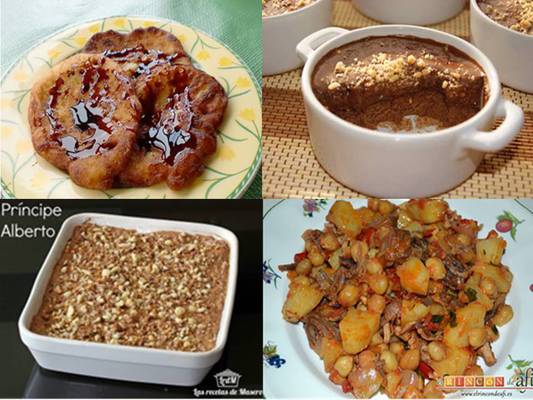
Lithuanian Fluffy Curd Cake
This is the dessert suggested by the Lithuanian Erasmus+ team from Kaunas. Among the ingredients used, we have to mention: curd, eggs, milk, semolina, butter, sugar, baking powder, and breadcrumbs. We explained to our project partners the six parts of the preparation process. A great joy will be for us to hear them they prepared it and liked it.
Kristina Joksiene, coordinator, Prezidento V. Adamkaus gimnazija, Lithuania
Lithuanian Fluffy Curd Cake.docx
Lietuviškas pūkuotas varškės pyragas
Tai desertas, kurį pasiūlė Lietuvos „Erasmus +“ komanda iš Kauno. Tarp naudojamų ingredientų turime paminėti: varškę, kiaušinius, pieną, manų kruopas, sviestą, cukrų, kepimo miltelius ir džiūvėsėlius. Savo projekto partneriams paaiškinome šešias pasiruošimo proceso dalis. Mums bus didelis džiaugsmas išgirsti juos, kurie jiems tai paruošė ir patiko.
Vita Janusiene, mokytojas in Prezidento V. Adamkaus gimnazija, Lietuva
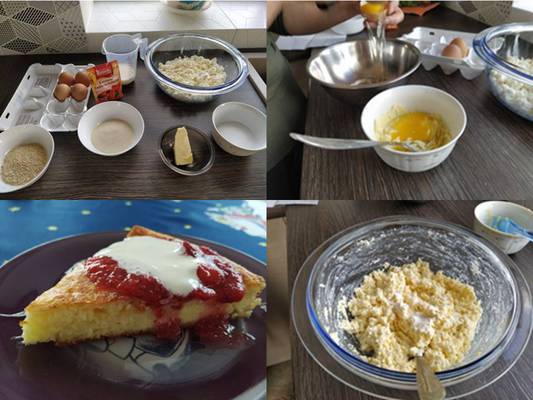
Polish Recipes for Menu
The Polish Erasmus+ project team decided to describe the following three dishes for a traditional menu: „Bigos”, tomato soup, and Faworki as a dessert. For each of them our pupils achieved a PowerPoint presentation, containing ingredients, preparations and suggestive photos. We hope all our partners will try to prepare them and taste these Polish traditional dishes.
Mariola Podolska-Maculewicz, Gimnazjum Nr 2 z Oddziałami integracyjnymi im. Michała Kajki, project coordinator
Polish Bigos.pptx
Polish Tomato Soup.pptx
Polish Faworki Recipe.pptx
Polskie Przepisy na Menu Polski zespół projektu Erasmus+ postanowił opisać następujące trzy dania do tradycyjnego menu: „Bigos”, zupa pomidorowa i Faworki jako deser. Dla każdego z nich nasi uczniowie wykonali prezentację PowerPoint, zawierającą składniki, sposób przygotowania i zdjęcia gotowych dań. Mamy nadzieję, że wszyscy nasi partnerzy postarają się je przygotować i skosztować tych polskich tradycyjnych potraw.
Dorota Dorozińska, dyrektor, Szkoła Podstawowa nr 2 z Oddziałami Integracyjnymi im. Michała Kajki w Nidzicy, Poland
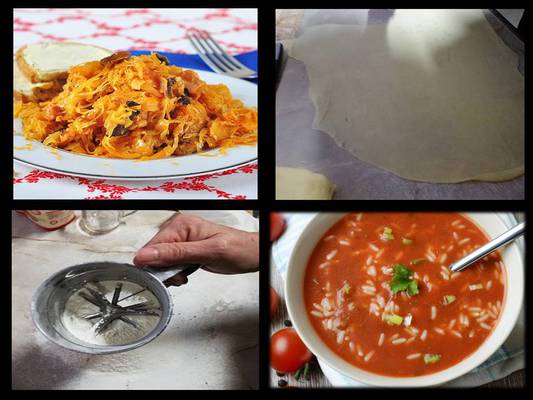
Cypriot Traditional Recipes
The Erasmus+ project team from Cyprus have prepared four recipes for their partners, one for a desert and three for a traditional menu. The ingredients and the methods of preparation are in the four Word document. A photo collage with representative images were added here for our project partners. We hope there will be a chalenge for them to prepare our menu.
Gabriella Theodosiou , coordinator, Gymnasium Apostolou Paulou, Cyprus
Cypriot Pupils Preparing Plasticio.docx
Cypriot Talaturi Recipe in the Menu.docx
Orange Pie - Dessert from Cyprus.docx
Salad from Cyprus in the Menu.docx
Kypriakés Paradosiakés Syntagés
I omáda érgou Erasmus + apó tin Kýpro échei etoimásei tésseris syntagés gia tous synergátes tous, mía gia érimo kai treis gia éna paradosiakó menoú. Ta systatiká kai oi méthodoi proetoimasías vrískontai sto tetrádio éngrafo tou Word. Éna koláz fotografías me antiprosopeftikés eikónes prostéthikan edó gia tous synergátes mas sto érgo. Elpízoume óti tha ypárxei mia chará gia na proetoimásoun to menoú mas.
Despina Fysentzou, dáskalos, Gymnasium Apostolou Paulou, Kýpros
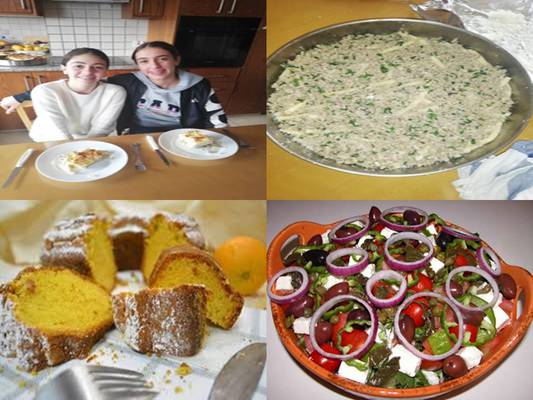
Cuisines
One of the tasks in the project is to try to cook partner countries’ dishes. Folklorica team chose a Spanish dessert and two students from the team tried it. The result was nice. The next day Spanish desserts reached school and we had a feast.
Fatma Karadoğan, teacher Vali M. Lütfullah Bilgin Ortaokulu, Turkey
Mutfak
Projedeki görevlerden biri ortak ülkelerin yemeklerini pişirmeye çalışmak. Folklorica ekibi bir İspanyol tatlısı seçti ve ekipten iki öğrenci denedi. Sonuç güzel oldu. Ertesi gün İspanyol tatlıları okula ulaştı ve bir ziyafet çektik.
Erkan Demirci, öğretmen Vali M. Lütfullah Bilgin Ortaokulu, Türkiye